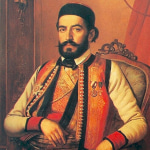Njegoš Day in Montenegro Date in the current year: November 13, 2026
 Njegoš Day is a public holiday in Montenegro celebrated annually on November 13. It honors the legacy of Petar II Petrović-Njegoš, a Montenegrin ruler, poet and philosopher whose epic poem Gorski vijenac is considered the national epic of Montenegro and Serbia.
Njegoš Day is a public holiday in Montenegro celebrated annually on November 13. It honors the legacy of Petar II Petrović-Njegoš, a Montenegrin ruler, poet and philosopher whose epic poem Gorski vijenac is considered the national epic of Montenegro and Serbia.Petar II Petrović-Njegoš was born Radivoje “Rade” Petrović on November 13, 1813 in Njeguši, a remote mountain village near Cetinje. His father, Tomislav “Tomo” Petrović, belonged to the Petrović clan, whose members had been hereditary prince-bishops (rulers of the Serbian Orthodox ecclesiastical principality of Montenegro) since 1696. The title was passed down from uncle to nephew because, as Orthodox prelates, prince-bishops were required to be celibate.
Rade spent most of his childhood in his home village shepherding sheep. When he was 12, monks at the local monastery taught him how to read and write. Rade then studied Italian, French, and Russian in other monasteries. In 1827, Serbian poet, translator and historian Sima Milutinović came to Montenegro to work as a secretary for Prince-Bishop Petar I Petrović-Njegoš, Rade’s uncle. Milutinović took it upon himself to oversee Rade’s education, introducing him to poetry and Serbian folklore. A former hajduk, he also taught Rade swordsmanship, marksmanship, and various sports.
When Rade was 17, Peter I chose him as his successor and sent him to study at a seminary, as well as introduced his nephew to the affairs of state. Peter I died of old age and ill health on October 30, 1830, and Rade was confirmed as the new prince-bishop, taking the monastic name of Petar in honor of his late uncle.
Njegoš spent the first years of his reign crushing domestic opposition. He then focused on ending clan feuds and uniting Montenegro’s tribes to create a cohesive state under a centralized government. Njegoš also introduced administrative and legal reforms (some of which were not popular), led several military campaigns against the Ottoman Empire, and laid some of the groundwork for the unification of Serbia and Montenegro.
Although Njegoš is generally regarded as a successful ruler, he is best remembered for his contributions to Montenegrin and Serbian literature. He began writing poetry at the age of 17; most of his works were inspired by Serbian folklore, lyric poetry, and biblical themes. Njegoš’s magnum opus is the epic poem Gorski vijenac (“The Mountain Wreath”), published in the Mekhitarist Monastery of Vienna in 1847.
The poem describes the mass execution of Montenegrins who had converted to Islam, which allegedly took place on a Christmas Day during the reign of Danilo I, the first prince-bishop of the House of Petrović-Njegoš. Its main themes are the national awakening and the struggle for freedom, justice and dignity.
In 2023, the birthday Njegoš was officially declared a national cultural holiday in Montenegro. Njegoš Day celebrates the legacy of the great Montenegrin poet and ruler, whose literary works are widely considered to be a remarkable contribution not only to Montenegrin literature, but to the literature of all South Slavic nations that once made up Yugoslavia.
- Category
- Public Holidays, Cultural Observances
- Country
- Montenegro
- Tags
- Njegoš Day in Montenegro, holidays in Montenegro, public holidays, cultural observances, Petar II Petrović-Njegoš